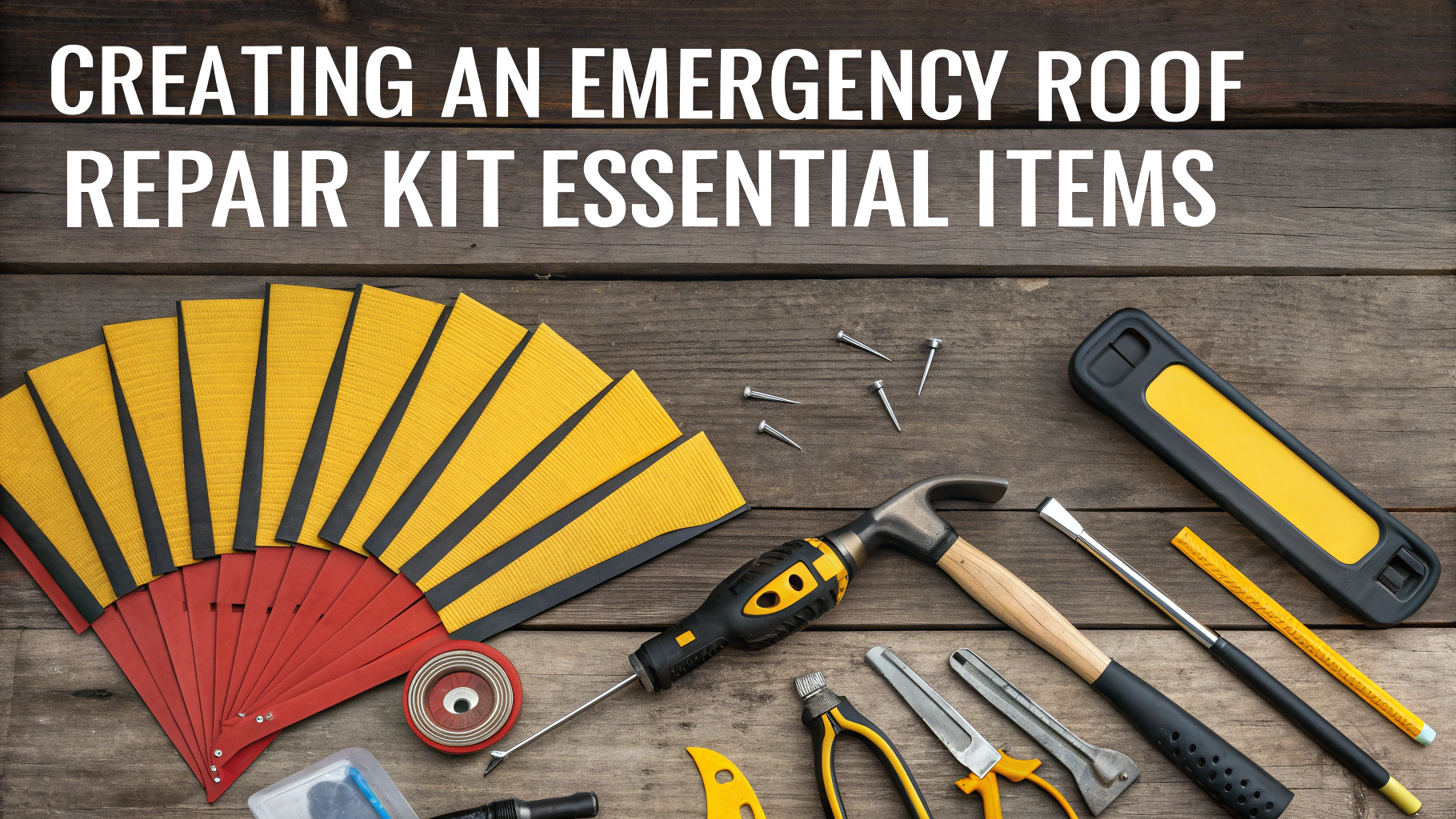A well-stocked emergency roof repair kit can help prevent minor roofing issues from becoming major disasters, especially during Colorado’s unpredictable weather patterns.
Quick repairs can protect your home from water damage while you wait for professional help, potentially saving thousands in repair costs.
This guide outlines the essential items needed for temporary roof repairs and proper storage recommendations to keep your kit ready for unexpected emergencies.
Basic Tools for Emergency Repairs
- Heavy-duty tarp (minimum 6-mil thickness)
- Roofing nails (1.5 to 2 inches long)
- Hammer or nail gun
- Utility knife with extra blades
- Safety gloves and goggles
- Measuring tape
- Chalk line or marker
Sealing and Patching Materials
- Roofing cement or sealant
- Self-adhesive roof patches
- Roll roofing material
- Rubber sheets
- Caulking gun
Safety Equipment
- Non-slip boots
- Safety harness
- Hard hat
- Flashlight or headlamp
- First aid kit
Storage and Maintenance Tips
Store your emergency roof repair kit in a waterproof container in an easily accessible location, such as your garage or storage shed.
Check the kit every six months to ensure materials haven’t expired or degraded.
Replace any used items immediately after performing repairs.
Important Contact Information
- Local roofing contractors (keep multiple numbers)
- Insurance company contact details
- Local building department: 303-441-1880 (Boulder County example)
- Emergency services: 911
Weather Protection Additions
- Extra tarps for different sizes of damage
- Sandbags for tarp anchoring
- Rope or bungee cords
- Weather-resistant tape
Taking Action During an Emergency
Document the damage with photos before attempting any repairs.
Contact your insurance company before making permanent repairs.
Only attempt repairs in safe weather conditions.
Next Steps for Roof Protection
Schedule regular roof inspections with qualified professionals to prevent emergency situations.
Consider upgrading roofing materials to more weather-resistant options suitable for Colorado’s climate.
Keep trees trimmed and gutters clean to minimize potential roof damage.
Professional vs DIY Repairs
While emergency repairs can provide temporary protection, knowing when to call professionals is crucial. DIY repairs should only address immediate threats until expert help arrives.
Some situations that require immediate professional attention:
- Structural damage to roof trusses
- Large areas of missing shingles
- Severe water infiltration
- Damage from fallen trees
Cost Considerations
Investing in a quality emergency repair kit typically costs between $200-$300, while professional emergency repairs can range from $500-$5000+.
Potential Savings
- Prevention of water damage to interior: $2,000-$10,000
- Avoidance of mold remediation: $1,500-$8,000
- Protection of insulation: $1,000-$3,000
Seasonal Preparation
Different seasons require different preparation strategies:
- Spring: Check for winter damage and prepare for rain
- Summer: Inspect for sun damage and prepare for storms
- Fall: Clear debris and prepare for winter
- Winter: Monitor ice dam formation and snow load
Securing Your Home’s Future
A well-maintained emergency roof repair kit serves as your first line of defense against unexpected damage. Regular updates to your kit, combined with preventive maintenance and professional inspections, create a comprehensive strategy for protecting your home’s integrity.
Remember that your safety comes first – when in doubt, always contact professionals for complex repairs or dangerous situations.
By following these guidelines and maintaining your emergency kit, you’ll be prepared to handle roof emergencies effectively while minimizing potential damage to your home.
FAQs
1. What essential items should be included in a basic emergency roof repair kit?
A good emergency roof repair kit should contain roofing tar, roofing nails, aluminum flashing, tarps, a pry bar, roofing sealant, a caulking gun, galvanized screws, and safety equipment like gloves and goggles.
2. How long can a temporary roof repair last?
A properly executed temporary roof repair can last anywhere from a few weeks to 6 months, depending on weather conditions and materials used, but should be replaced with a permanent solution as soon as possible.
3. What’s the correct way to apply a tarp for emergency roof coverage?
The tarp should extend from the peak of the roof and at least 4 feet past the damaged area on all sides. Secure it with 2×4 boards along the edges, using screws every 16 inches, and ensure it’s pulled tight to prevent water pooling.
4. When is it unsafe to attempt DIY emergency roof repairs?
DIY repairs are unsafe during storms, high winds, when there’s ice or snow present, if the roof’s structural integrity is compromised, or if the pitch is too steep. These situations require professional intervention.
5. What type of sealant works best for emergency roof repairs in Colorado’s climate?
Polyurethane-based sealants are most effective for Colorado’s climate as they can withstand extreme temperature changes, UV exposure, and maintain flexibility in both hot and cold conditions.
6. How can I quickly identify the source of a roof leak during an emergency?
Track water stains upward from where they appear inside the house. Look for damaged or missing shingles, compromised flashing around vents or chimneys, and check the attic during daylight for points where light penetrates.
7. What size tarp should I keep in my emergency roof repair kit?
Keep at least a 20′ x 30′ heavy-duty tarp (minimum 6-mil thickness) in your kit. This size will cover most residential roof damage scenarios while providing adequate overlap for proper water diversion.
8. How should emergency roof repair materials be stored to ensure they’re ready when needed?
Store materials in a dry, temperature-controlled environment. Keep adhesives and sealants in temperatures between 40-80°F, check expiration dates annually, and store tarps folded properly to prevent degradation.
9. What special considerations should be made for emergency repairs during Colorado winters?
Winter repairs require special cold-weather sealants rated for below-freezing temperatures, ice shield membrane for ice dam prevention, and extra safety precautions due to slippery conditions.
10. How often should emergency roof repair kit supplies be checked and replaced?
Inspect your emergency kit every six months. Check sealants and adhesives for expiration dates, ensure tarps haven’t degraded, and replace any weathered or damaged materials immediately.
